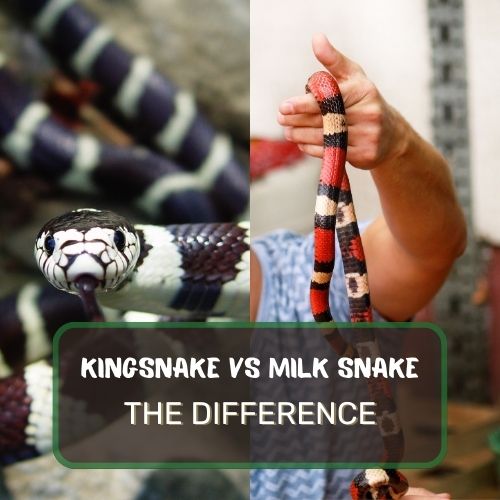Diving into the captivating world of milk snakes?
These colorful reptiles are a joy to care for, but, like all pets, they have their unique needs. This comprehensive guide will shed light on “milk snake tank requirements” to ensure your slithery friend feels right at home.
We’ll unravel the mysteries of the ideal tank size, the perfect substrate, the nuances of lighting, and more.
Whether you’re a newbie or a seasoned reptile enthusiast, buckle up for an enlightening journey into the habitat needs of the milk snake!

Table of Contents
- 1 The Right Tank Size: Giving Your Milk Snake Space
- 2 Substrate Choices: Lay the Groundwork
- 3 Humidity and Temperature: Creating a Comfortable Ambience
- 4 Lighting: Shedding Some Light on the Subject
- 5 Decoration and Enrichment: Making It Homey
- 6 Water and Hydration: Quenching Their Thirst
- 7 Safety and Security: Keeping Your Slithering Friend Safe
- 8 Final Word
- 9 FAQ
The Right Tank Size: Giving Your Milk Snake Space
Believe it or not, the milk snake does not demand a vast savannah or sprawling jungle to thrive. However, it does have some non-negotiables when it comes to its living quarters.
Recommended Sizes for Baby Milk Snakes
Imagine living in a vast mansion when all you really want is a cozy studio apartment. Baby milk snakes don’t need an expansive palace right off the bat. Starting them off in a 10-gallon tank is often ideal.
It’s big enough for them to stretch and explore but not so vast that they feel lost or overwhelmed.
Growth Patterns and How They Affect Tank Size
As your snake friend grows (and they will!), their spatial needs will evolve. Milk snakes can reach up to 4 feet as adults! With this growth, it’s no surprise that they’ll need a larger space.
Typically, when your milk snake begins to grow and thrive, you should consider upsizing to a 20-gallon tank or larger. Think of it as upgrading from that studio apartment to a more spacious two-bedroom condo.
Square Footage vs. Height
Here’s a tidbit: milk snakes are more about floor space than climbing great heights. While some snakes are avid climbers and would love a tall tank with lots of vertical space, milk snakes prefer to slither around the ground.
Prioritize the width and depth of the tank over its height. It’s like having a preference for a sprawling ranch-style home instead of a towering penthouse.
In a nutshell? It’s not just about giving our milk snake space, but the right kind of space.
Consider their age, their growth, and their ground-loving nature when setting up their home. It’s like interior decorating but for a snake – and trust me, they’ll appreciate the effort!

Substrate Choices: Lay the Groundwork
Substrate? Sounds fancy, doesn’t it? But for our slithery friends, it’s akin to the kind of flooring we’d choose for our homes. Hardwood, carpet, tile – all of these make a difference to our comfort.
Similarly, the right substrate is crucial for a milk snake’s well-being.
Preferred Substrates
Milk snakes are fans of substrates that mimic their natural habitat. Aspen shavings, cypress mulch, and coconut husk are all excellent choices.
These substrates hold moisture well (helpful for maintaining humidity levels) and are comfortable for milk snakes to move around on. Imagine it as the snake equivalent of plush carpeting – feels great and looks fantastic!
Avoidable Substrates
On the flip side, substrates like cedar and pine shavings should be avoided. These emit oils that can be harmful to our reptilian companions. Plus, sand and gravel aren’t the best options either; they don’t retain moisture and can be abrasive.
It’s like opting for sandpaper flooring – not the coziest of choices!
Changing and Cleaning Routines
Keeping the substrate clean is non-negotiable. Once a week, spot clean any waste and replace wet or soiled substrate. And once a month? A complete substrate change and a thorough tank clean are in order.
It’s all about maintaining that fresh, clean, and homey environment.

Humidity and Temperature: Creating a Comfortable Ambience
Who doesn’t love a room at just the right temperature? Your milk snake is no different. In fact, getting the humidity and temperature right isn’t just about comfort, it’s about health.
Ideal Humidity Levels
For milk snakes, humidity levels between 50% to 70% hit the sweet spot. Proper humidity aids in shedding and overall health. Too low, and they could have shedding problems; too high, and you’re looking at potential respiratory issues.
Temperature Gradients Needed
Here’s where it gets interesting. Milk snakes don’t want an even temperature throughout their tank. They crave a temperature gradient.
On the warmer side, aim for temperatures between 85°F to 90°F, and on the cooler end, shoot for 70°F to 75°F. This allows our cold-blooded buddies to thermoregulate – a fancy term that means they can move around and choose their ideal temp.
Best Tools and Gadgets for Monitoring
In our tech-savvy world, monitoring the tank’s conditions has never been easier. Digital hygrometers and thermometers are your new best friends. Easy to read and precise, they’ll give you the low-down on the tank’s conditions in a jiffy.
Consider using a thermostat-controlled heating mat or tape for maintaining that gradient. Always ensure that these gadgets are safely placed to prevent any curious snake investigations!
Ultimately, whether it’s laying the perfect substrate or achieving that sublime temperature gradient, it’s all about creating the optimal living conditions for your milk snake. After all, a happy snake is a healthy snake!

Lighting: Shedding Some Light on the Subject
Lighting isn’t just about illuminating spaces. For our milk snakes, it’s about regulating their internal clocks and maintaining their well-being.
The Role of Natural Light
Milk snakes thrive when exposed to natural day-night cycles. Positioning their tank in a room with natural sunlight (but not direct sunlight, mind you!) helps keep their circadian rhythms in check.
It’s like us feeling refreshed and awake during the day and getting drowsy when it’s dark.
Artificial Lighting Options
Can’t get enough natural light? No worries! There are plenty of artificial lighting options. Fluorescent or LED bulbs designed for reptiles can be a great addition. They provide the necessary brightness without emitting too much heat.
Photoperiod – How Much Light Does a Milk Snake Really Need?
Milk snakes typically thrive with around 12 hours of light and 12 hours of darkness. This balance ensures they get enough rest while also benefiting from active hours.
A simple timer can help maintain this schedule, ensuring your snake has a rhythmic and natural light cycle.

Decoration and Enrichment: Making It Homey
A house becomes a home with personal touches, right? It’s the same with milk snake tanks.
Plants, Logs, and Hides
Plants (real or artificial) add a touch of greenery, making the environment feel more natural. Logs and hides? They’re essential! Milk snakes are, by nature, secretive creatures. They adore snug hiding spots where they can feel safe and secure.
Importance of Climbing Structures
While they might be ground-lovers, milk snakes still enjoy a little vertical exploration. Offering climbing branches or structures can provide them with the chance to stretch out and explore their environment from a different vantage point.
Benefits of Variety in Tank Décor
Changing up the décor isn’t just about aesthetics. Introducing new items or rearranging existing ones can mentally stimulate your snake, keeping them curious and engaged. It’s akin to us rearranging our furniture for a fresh look and feel.
Remember, setting up a tank isn’t just about meeting basic requirements. It’s about creating a space where your milk snake can thrive, feel secure, and be mentally stimulated. After all, a lively and engaged snake is a joy to observe!

Water and Hydration: Quenching Their Thirst
Water – it’s the essence of life! And for our milk snake, it’s an absolute necessity.
Proper Water Dish Sizes
For milk snakes, the water dish shouldn’t be a tiny teacup, nor should it be a vast lake. A medium-sized dish, large enough for them to curl up in if they fancy a soak, is just right. Think of it as their personal mini-pool.
Placement in the Tank
Position matters. Place the water dish on the cooler side of the tank. This ensures the water doesn’t evaporate too quickly and remains cool, offering a refreshing sip whenever they please.
Freshness and Cleanliness Considerations
Stagnant water? Nope! Milk snakes deserve fresh water, changed daily. Regularly cleaning the dish itself is equally important, ensuring no bacteria or unwanted guests are lurking.

Safety and Security: Keeping Your Slithering Friend Safe
With homes come responsibilities. And ensuring the safety of our milk snake is top of the list.
Lid and Lock Requirements
A tight-fitting lid is non-negotiable. Why? Milk snakes are quite the little Houdinis. To add an extra layer of protection, securing the lid with a lock or latch is a wise move.
Protecting from Other Pets
Have a curious cat or a nosy dog? It’s essential to place the tank in an area where other pets can’t pester or potentially harm your snake. High shelves or dedicated reptile rooms can be a safe haven.
Preventing Escapes
Besides a secure lid, routinely check the tank for any gaps or openings. Whether it’s the mesh or the area where cords pass through, seal off any potential escape routes. Remember, a milk snake on the loose is more than just a game of hide and seek!
Keeping a milk snake safe is about vigilance and foresight. With the right measures in place, they’ll have a secure and happy home for years to come.
Final Word
You’ve journeyed through the intricate world of milk snake tank requirements, from understanding the ideal tank size and substrates to lighting and hydration needs.
It’s evident that creating a comfortable environment for your milk snake involves care, knowledge, and a dash of enthusiasm. Remember, each step you take ensures your snake’s well-being and happiness.
Armed with this information, you’re well on your way to providing a stellar home for your slithery friend. Keep up the dedication, and enjoy the rewarding experience of caring for your milk snake!
FAQ
Let’s dive into some frequently asked queries about milk snake tank requirements.
Do Milk Snakes need hide?
Absolutely! Hides are essential for milk snakes. They love their privacy and often seek out cozy, dark spots to relax and de-stress. Think of hides as their little safe havens, their personal retreats from the hustle and bustle of the tank world.
What size tank do Milk Snakes need?
Start baby milk snakes in a 10-gallon tank. As they grow, and boy, they do grow, consider upgrading to a 20-gallon tank or larger. It’s all about giving them the right space to slither, explore, and thrive.
Do milk snakes need light?
Yes, indeed! Milk snakes benefit from a balanced light-dark cycle. Natural sunlight is excellent, but artificial lighting options like fluorescent or LED bulbs designed for reptiles can also do the trick.
What does a milk snake need in its cage?
Apart from love and care? A proper substrate, a water dish, hides, climbing structures, and appropriate lighting are key. Sprinkle in some decorative elements like plants and logs, and you’ve got a comfy, cozy, and stimulating home ready for your slithery pal!




0 Comments